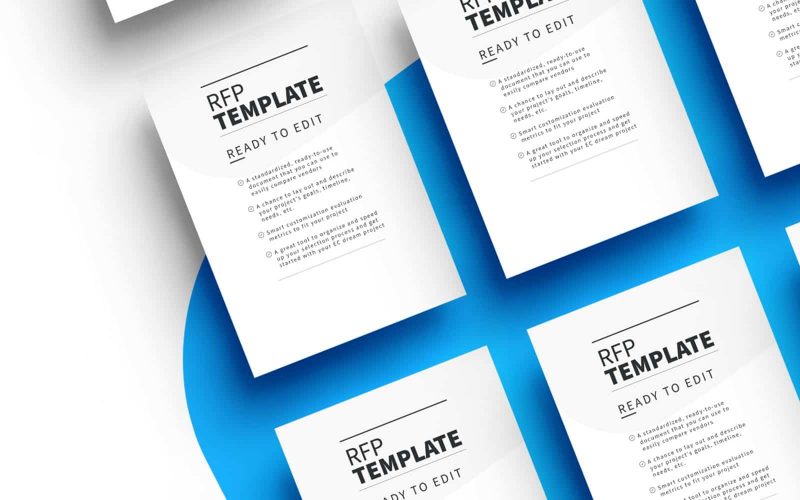Knowing how to create an RFP is critical for busy business owners, marketing managers, and other professionals entrusted with outsourcing work for their brands. It will save you time, money, and resources, attract top-tier vendors, and help you achieve success like never before. We’re digging into the world of Request for Proposal (RFP) templates today. If, like me, you’ve been frustrated by the intricacies and time-consuming nature of creating an RFP, buckle up because we’re about to embark on a game-changing journey. In this blog post, I’ll show you how to create an effective RFP with our free RFP template that will transform your procurement process.
What is an RFP?
A request for proposal is a document that a company creates when it wants to solicit various bids for one (or more) outsourced tasks.
Assume you are an auto parts company seeking a few bids for a new ad campaign announcing the launch of a new body shop. You should ensure that the contractors or digital marketing organizations bidding for this task are aware of this.
Key Takeaways
- RFPs are essential documents for soliciting bids and making informed decisions in outsourcing tasks.
- A well-written RFP is key to saving time and resources, attracting the right vendors, and ensuring successful project outcomes.
- Clearly outlining specific project requirements in the RFP ensures vendors understand expectations, leading to more relevant proposals.
- Transparent and objective evaluation criteria in the RFP process ensure fair and merit-based selection of vendors.
- Effective communication throughout the RFP process, including clear points of contact and prompt responses, builds trust and clarity.
- Building and maintaining strong relationships with vendors beyond the RFP process enhances long-term partnerships and project success.
- Customizing RFP templates to fit specific organizational needs ensures the RFP accurately reflects the unique aspects of the project and requirements.
Importance of a Well-Written RFP Template
As someone deeply involved in the procurement process, I’ve had my fair share of experiences with RFPs, both from the perspective of issuing them and responding to them. These experiences have provided me with invaluable insights into what truly makes an RFP effective and how it can be a powerful tool for finding the right vendor.
Crafting an RFP for a Major Tech Implementation
One of my most challenging yet rewarding experiences was when our company needed to procure a complex tech solution. We required a new CRM system that could integrate seamlessly with our existing tech stack. The process of drafting the RFP was intricate, as it demanded not only a deep understanding of our current infrastructure but also a vision of how the new system would fit into our future growth plans.
Key Takeaway: The critical aspect was the detail in our requirements section. We had to be extremely specific about the technical specifications, integrations, and scalability we were looking for. This level of detail stemmed from numerous internal discussions and consultations with our IT team, ensuring that every potential vendor clearly understood our expectations.
Evaluating Proposals: A Balancing Act
Once the proposals started coming in, the real work began. Evaluating each proposal was like piecing together a complex puzzle. We had to consider not just the cost but also the long-term value each vendor could bring. It was a rigorous process that involved cross-departmental collaboration to ensure every angle was covered.
Key Takeaway: The winning vendor was not the one with the lowest price, but the one that demonstrated a clear understanding of our needs and could offer a comprehensive solution that aligned with our long-term goals.
Lessons Learned and Best Practices In Crafting an RFP
#1. Collaboration is Key
One of the most significant lessons I learned through my RFP experiences is the importance of collaboration. Involving various stakeholders from the beginning ensures a more comprehensive RFP document and a better evaluation process.
#2. Continuous Vendor Engagement
Another key insight was the importance of maintaining communication with vendors throughout the process. This not only helps in clarifying doubts but also in building a relationship with potential partners.
#3. The Power of Feedback
Providing detailed feedback, both to the winning and losing vendors, is crucial. It not only helps them improve but also establishes a foundation for future collaborations.
I encourage you to use these insights to enhance your RFP process. Remember, each RFP is an opportunity to not only find a vendor but to also build a partnership that can contribute to your organization’s success.
Now that we’ve agreed on the significance of a well-crafted RFP, let’s dive into the important components. I will tell you how to identify those key templates that stand out from the engaging introduction that catches merchants’ attention to the submission rules that make the process a breeze.
Key Components of the RFP Template
I will go over each component in depth, providing important insights and expert advice along the way. This is where the magic happens, believe me!
Creating an Irresistible RFP Template
#1. Establishing the Tone
First impressions are important, and the introduction of your RFP is no exception. This is your time to fascinate vendors and entice them to read more about your proposal. I started by giving a quick summary of the organization, project, and goals. Creating a dynamic image that highlights my distinct perspective and piques the interest of vendors. Remember, that’s because I want to stand out from the crowd and make vendors want to be a part of your adventure.
#2. Sharing Your Story
I move beyond the facts and figures to begin interacting with vendors. Share my experience, my struggles, and my goals. Allow my enthusiasm and determination to shine through. By incorporating actual emotions into my writing, I establish a personal connection that lays the groundwork for a good collaboration. Vendors want to partner with organizations that inspire them, so I am never afraid to be vulnerable.
As someone who has walked in your shoes while navigating the procurement landscape, I recognize the value of sharing firsthand knowledge. Let’s dig into the trenches together and talk about our successes and failures. I can provide significant insights and practical guidance to vendors by relying on my own experiences. It’s the secret ingredient that gives my RFP template credibility and authenticity.
Having talked about the important component, let us review how to navigate through the scope of your project.
Understanding How RFP Works
#1. Creating a Universe for Your Project
Oh, the vastness of the job. This part is where you define the scope of your project or the services you are looking for. Be specific about deliverables, timelines, and any other details that vendors should be aware of. Leave no room for doubt! Setting clear expectations ensures that vendors know what they’re getting into and can make realistic proposals. Clarity is essential, my friends!
#2. Embracing Specificity to Achieve Success
Let us be more precise, will we? In this part, you’ll establish the specific requirements and standards that vendors must address in their submissions. Don’t be shy! Be meticulous and supply as much information as possible. Leave no stone untouched, from essential requirements to preferred qualifications. The more specific you are, the better providers will be able to modify their proposals to match your requirements. It’s a no-lose situation!
#3. An Exploration of Evaluation Criteria
Let me now discuss the evaluation criteria. These are the guiding lights that will assist you in navigating the sea of bids and making sound decisions. In this part, you will describe the criteria for evaluating vendor proposals. Assign weight to each criterion and establish explicit instructions for vendors to follow. Transparency is essential, my friends! By being open about your review process, you empower vendors to tailor their proposals to your needs.
RFP Template Guidelines Made Easy
#1. Simple Formatting
To begin, choose a file format for submission, such as PDF or Word. This makes it possible for all proposals to be easily accessed and reviewed. Outline any additional formatting needs, such as font size, margins, or spacing. Formatting consistency aids in a more efficient review process and keeps information from getting lost in the shuffle.
#2. Making Use of User-Friendly Templates
Include placeholders and instructions in the template to prompt vendors to contribute the required information. You may, for example, offer spaces in the pricing section for vendors to submit their recommended costs and any other pricing considerations. You minimize guesswork and make it easy for vendors to align their proposals with your criteria by doing so.
#3. Communication is crucial.
Communication is more important than ever in this digital age. Consider creating a dedicated email address or a project management platform where vendors can submit their inquiries to further expedite the communication process. Respond to inquiries as soon as possible, indicating your dedication to openness and maintaining a great vendor experience. Clear communication fosters trust and a sense of collaboration, laying the groundwork for fruitful collaboration.
The Procedure of Evaluation and Selection Using RFP Template
#1. Exposing the Evaluation Technique
Now that the offers have arrived, it’s time to dig in and begin the evaluation process. Outline how you will evaluate and compare vendor proposals in this area. Explain the criteria you’ll be using, the weighting assigned to each criterion, and any grading rubrics or matrices you’ll be using. Clarity in the review process guarantees that all vendors are treated fairly and transparently.
#2. Promoting a Collaborative Selection Procedure
To guarantee a comprehensive assessment, key stakeholders and subject-matter experts must be involved in the proposal evaluation process. Collaborative decision-making brings several points of view to the table, resulting in more informed decisions and the discovery of the best-fit vendor. Encourage team collaboration and communication by creating an environment where expertise and insights may be shared.
#3. The Effectiveness of Objective Decision-Making
Objectivity is essential in the quest of fairness. Insist on making decisions based on the merits of each proposal rather than personal biases or prior preconceptions. Remind the evaluation team to stay objective and to focus on the proposals’ fit with your organization’s goals and objectives. Transparent and objective decision-making fosters trust and ensures that all vendors compete on an equal playing field.
How to Improve Vendor Experience Using RFP Templates
#1. Giving Feedback and Outcomes
As the review process winds down, it’s critical to provide feedback to vendors, regardless of whether they were chosen. Constructive criticism enables bidders to identify their strengths and areas for improvement, allowing them to better their proposals for future opportunities. Be descriptive, highlighting what wowed you about their plan or what should be improved. You support growth and contribute to a positive vendor ecosystem by providing meaningful input.
#2. Establishing Stable Vendor Relationships
Remember that your relationship with the chosen vendor goes beyond the RFP process. Emphasize the importance of developing strong connections with vendors in this area. Encourage open lines of communication, regular check-ins, and opportunities for collaboration. By cultivating these relationships, you will unlock creativity, improve performance, and build a network of trusted vendors eager to help your organization succeed.
RPF Template Sample
[Your Company’s Name] [Your Company’s Address] [City, State, ZIP Code] [Phone Number] [Email Address] [Website] [Date] [Client’s Company Name] [Client’s Company Address] [City, State, ZIP Code]Subject: Request for Proposal (RFP): [Project/Service Name]
Dear [Client’s Name],
We are pleased to submit this Request for Proposal (RFP) on behalf of [Your Company’s Name]. We have carefully reviewed your requirements and believe that our expertise and experience make us an ideal candidate to fulfill your [Project/Service Name] need
Introduction:
Provide a brief introduction to your company, highlighting your background, experience, and relevant achievements. Emphasize why your company is well-suited to handle [project/service name].
Project Overview:
Clearly define the scope and objectives of the project. Include any specific deliverables and milestones that need to be met. Provide background information on the project, its purpose, and its expected outcomes.
Requirements:
Outline the specific requirements of the project. Include both functional and technical requirements, as well as any constraints or limitations. Be as detailed as possible to ensure a comprehensive understanding of your needs.
Timeline:
Specify the desired project timeline, including key milestones and deadlines. This will help potential vendors assess their availability and ability to meet your timeline requirements.
Budget:
Provide a budget range or an estimated budget for the project. This will help vendors determine if they can deliver the desired results within your financial constraints.
Evaluation Criteria:
Clearly state the criteria that will be used to evaluate proposals. This may include factors such as experience, qualifications, approach, pricing, and references. Provide weighting or scoring guidelines, if applicable.
Proposal Submission:
Specify the deadline for submitting proposals and any specific submission requirements, such as format (e.g., PDF, Word document) or delivery method (e.g., email, physical mail).
Vendor Information:
Request vendors to provide their company background, relevant experience, client references, and any certifications or accreditations that are pertinent to the project.
Terms and Conditions:
Include any necessary legal or contractual terms and conditions that vendors will be required to comply with if selected.
Confidentiality:
Specify any confidentiality requirements for the proposal and the project, particularly if sensitive information will be shared during the selection process.
Contact Information:
Provide the name, email address, and phone number of the point of contact for any questions or clarifications regarding the RFP.
We look forward to receiving your proposal and would be happy to address any questions or concerns you may have. Thank you for considering [your company’s name] for this opportunity.
Sincerely,
[Your Name] [Title] [Your Company’s Name]You can use this free RFP template below:
What makes an RFP successful?
RFPs must clarify the bidding procedure and contract terms while also offering specific instructions on how offers should be submitted. The RFP should describe the nature of the project or requirement as well as how one can evaluate the bid—the assessment criteria and the mechanism for grading proposals.
How Can I Tailor a Free RFP Template to My Specific Needs?
- Customizing the introduction to reflect the unique qualities of your firm.
- Changing the scope of work to meet the needs of your project.
- Adding or changing certain requirements to achieve your goals.
- Changing the evaluation criteria to fit your organization’s priorities.
- Adding a personal touch to submission requirements and contact information.
What are Some Common Mistakes to Avoid When Applying RFP Templates?
Avoid typical errors by:
- Ensure that your criteria are clear and specific.
- Adapting the template to your organization’s specific needs.
- Providing thorough evaluation criteria.
- Before distribution, check the template’s completeness.
- The template update should reflect changes regularly.
Using free RFP templates to improve your procurement operations is a sensible approach. You can use this free template:
Are Free RFP Templates Applicable in All Industries?
Yes, our free RFP templates are intended to be adaptable across a wide range of sectors. However, it is critical to select a template that closely matches your industry’s specific criteria and regulations.
Conclusion
By developing a fascinating introduction, defining clear expectations, simplifying the submission procedure, and embracing transparent evaluation, you’ve successfully launched a quest to transform your procurement process with the help of our free RFP template and also laid the groundwork for success. Continue to refine your RFP template, cultivate excellent vendor relationships, and embrace continuous improvement.
It’s now your time! What obstacles did you face during the RFP process, and how did you overcome them? Comment here with your thoughts, experiences, and advice. Let’s keep the conversation going and share our collective wisdom. We can redefine procurement excellence together!
How has a successful RFP template impacted your company’s buying process? Share your thoughts and experiences in the comments section below!
- What Is An RFP (Request For Proposal): All You Need To Know
- All You Need to Know to Implement a Proper Grant Management System
- VENDOR LIABILITY INSURANCE: What It Is, Types, Coverage & Cost 2023
- Business NET 30 ACCOUNTS 2023: Top Picks & All You Need to Know
- How To Apply For Government Grants




